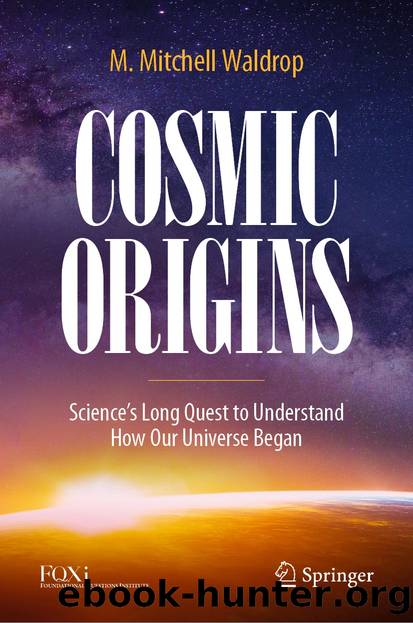Cosmic Origins by M. Mitchell Waldrop

Author:M. Mitchell Waldrop
Language: eng
Format: epub
ISBN: 9783030982140
Publisher: Springer International Publishing
The answer again went back to Sakharov, who had pointed out in 1966 that quantum fluctuations during the very first instants of the Big Bang would have caused subtle variations in the density of the primordial plasma [43]. As small as these variations were to begin with, Sakharov noted, they would have expanded along with the rest of the universe. And over the billions of years since, the inexorable pull of gravity would have caused the denser regions to contract and grow denser still, until they condensed into galaxies, clusters, and other massive structuresâamong them our own Milky Way galaxy.
If Sakharov was right, in other words, we owe our existence to quantum fluctuations that occurred billions of years ago, in the universeâs first infinitesimal fraction of a second.
Physicists at the Lebedev Institute revived Sakharovâs idea in 1981, and applied it to the version of inflation developed by their colleague Starobinsky [44, 45]. Then a year later, other teams of physicists rushed to do the same for the recently invented theory of new inflation; they published their work in four separate papers that grew out of the Nuffield Symposium: a two-week workshop organized by Stephen Hawking and others in Cambridge, UK, during the summer of 1982 [46â49].
The consensus in these papers was that the GUT scalar fieldâor, as many physicists took to calling it, the inflatonâwould indeed undergo quantum fluctuations while it was slowly rolling off that high dome. Intuitively speaking, it was as if the inflaton were a marble being randomly jostled as it moved. At some points in the infant universe the marble would randomly be kicked forward, so to speak, so that the graceful exit from inflation got accelerated ever so slightly. But at other points the marble would randomly be kicked backwards, and the exit would be ever so slightly retarded. The net effect would be just the kind of variations in density and temperature that Sakharov had predicted.
Better still, the physicists agreed, these variations might just show up as subtle shifts in the temperature of the CMB at different points on the sky.
They were right. As we discuss in the next chapter, researchers working with NASAâs Cosmic Background Explorer (COBE) satellite would announce in 1992 that they had found CMB temperature variations with exactly the properties expected from quantum fluctuations [50]. Moreover, these findings would continue to hold up when later satellites mapped the CMB in much finer detail. And in the meantime, a multitude of computer simulations would confirm that gravity could indeed have taken these density perturbations and produced the observed distribution of galaxies.
Download
This site does not store any files on its server. We only index and link to content provided by other sites. Please contact the content providers to delete copyright contents if any and email us, we'll remove relevant links or contents immediately.
The Complete Stick Figure Physics Tutorials by Allen Sarah(7334)
Secrets of Antigravity Propulsion: Tesla, UFOs, and Classified Aerospace Technology by Ph.D. Paul A. Laviolette(5330)
Thing Explainer by Randall Munroe(3905)
The River of Consciousness by Oliver Sacks(3570)
The Order of Time by Carlo Rovelli(3162)
How To by Randall Munroe(3074)
A Brief History of Time by Stephen Hawking(2990)
I Live in the Future & Here's How It Works by Nick Bilton(2957)
What If?: Serious Scientific Answers to Absurd Hypothetical Questions by Randall Munroe(2667)
The Great Unknown by Marcus du Sautoy(2661)
Midnight in Chernobyl by Adam Higginbotham(2515)
Blockchain: Ultimate Step By Step Guide To Understanding Blockchain Technology, Bitcoin Creation, and the future of Money (Novice to Expert) by Keizer Söze(2465)
Networks: An Introduction by Newman Mark(2382)
The Meaning of it All by Richard Feynman(2317)
Easy Electronics by Charles Platt(2307)
The Tao of Physics by Fritjof Capra(2247)
Midnight in Chernobyl: The Untold Story of the World's Greatest Nuclear Disaster by Adam Higginbotham(2195)
When by Daniel H Pink(2098)
Introducing Relativity by Bruce Bassett(2097)
